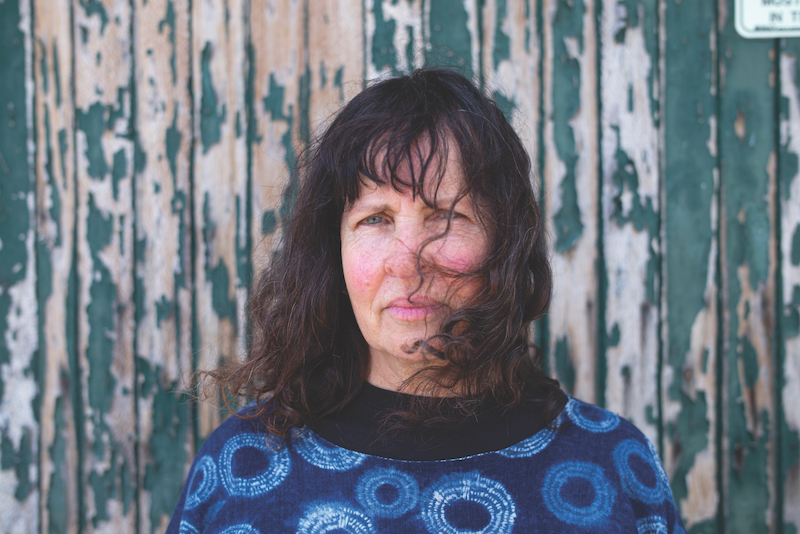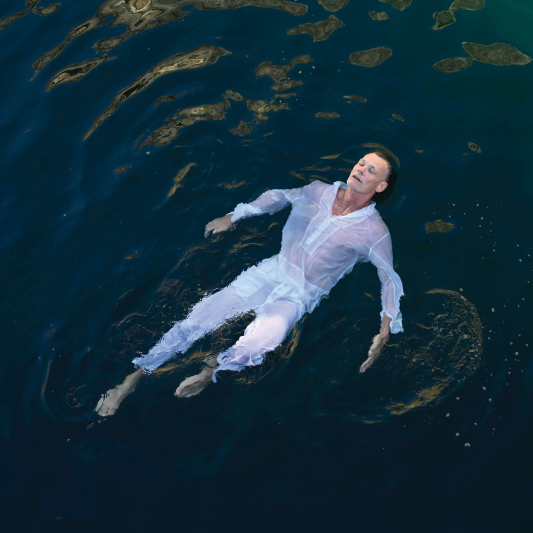Judy Watson: Such Poetry
It’s rare to find the work of an artist so prolific remain as considered, poetic, and important as that of Judy Watson.
Words: Louise Martin-Chew
Photography: Russell Shakespeare
Judy Watson has an ability to take difficult subject matter and render it not only compelling but seductively beautiful – and it is this that places her at the heart of contemporary Australian art. She is a powerhouse of production, often with so many projects on the go that it is hard to imagine how they can be so intricately conceptualised and delivered. Yet she proceeds, with quiet inclusivity, inviting emerging artists, the community and a team of collaborators to be part of an ongoing journey through material that traverses her Aboriginal heritage and history, Country, the environment, climate change, marginalised groups, and the racism and injustice that continues to be levelled at First Nations peoples.
Watson is a painter known for her unframed canvases, stained colour and imagery that floats. Canvases move against the wall with the air, with their form and motifs evoking Watson’s Waanyi (running water) heritage from north-west Queensland, but also contemporary experience.
She is a printmaker, known for her etchings and artist books – notably a preponderance of aboriginal blood which was re-editioned late last year and includes narratives of Aboriginal individuals drawn from the Queensland archive. She has produced public art all over the world, with recent commissions including the sculpture juguma (with UAP) for the University of Sydney and another underway with the Port of Brisbane. Then there is a recent multimedia work water under the bridge (commissioned by the Brisbane City Council to be screened at Howard Smith Wharves late in 2020) which traces Watson’s journey through the black and white history of Brisbane, including some elements that have been previously unknown or forgotten.
Even in this Covid-19 plagued year, Watson opened her largest international exhibition to date at Birmingham’s IKON Gallery in March, making it back to Australia just prior to Brisbane’s lockdown period. This exhibition, titled Looking Glass, sees Watson, paired (by curator Hetti Perkins) with fellow artist Yhonnie Scarce, and opens at TarraWarra Museum of Art outside Melbourne in November, to tour Australia from 2021.
For Looking Glass, Watson made new work inspired by her experience of the ancient standing stones in the United Kingdom combined with motifs like the Queensland bunya leaf, grevillea and the energetic presence of whorls and spirals. “My idea was to have images of standing stone forms – shadowy or very ghostly presences – and the floating of Aboriginal cultural material across the top,” she says. “It’s a layering of experiences and a layering of understanding of what is culture.”
Other aspects of her oeuvre are also represented, providing context. grandmother’s song (2007) refers to Grace Isaacson, Judy’s maternal grandmother, who began work as a young child on a station. Away from her mother and family, Isaacson only reconnected with them when she was pregnant with Judy’s own mother on another property.
The indigo and ultramarine blues are a touchstone in Watson’s practice, and contribute to a characteristic fluidity in colour and form. Also included is 40 pairs of blackfellows’ ears, lawn hill station (2008), which draws out of history the true story of a Queensland pastoralist, educated at an elite Victorian school, who boasted of his murders of local Aboriginal people, nailing their ears as trophies onto the slab hut walls of his homestead.
The inherent sadness and violence behind his imagery is ameliorated by its sensitive treatment, and Watson’s transformative powers between the subject and the art. Perkins suggested that in the pairing (Watson and Scarce), audiences may find “a panoptic and holistic portrait of Country where the creation and experience of art is mnemonic for the lived, remembered and inherited history of Aboriginal people. Yet, while their works may refer to specific events, their enigmatic and often intimate forms, gestures and marks also imply an immersive timelessness outside of a linear chronology, outside of this accidental present; an existence today that is more than the now.”
When we speak, Watson is immersed in the painting of her November exhibition at Tolarno Galleries in Melbourne. These canvases reach into the engrossing nature of the now, with the updates, graphs and evolving science of the pandemic that we experience on our screens, projected into her other motifs such as nets, indigenous plants, feathers and shells.
“The initial colour background on many of the canvases is indigo dye,” she says. “These were done in two batches to lay down the blue grounds using various materials inserted in between the canvas and the dye. The canvases have been walked and danced on by myself, my son and his friend, and the canvas grounds have been washed and then pinned to the wall in my studio.”
Indigo is important for its value as a traded resource, like ochre, with transformative properties. It is, for Watson, also “the colour of memory, dreamy and liquid, transporting us to a level of deep consciousness”, and is “other worldly, a blue mirage”.
Tangible evidence from Watson’s daily life is painted to evoke the physical, mental and psychological realities of the present. “Everywhere I walk I have picked up things like bits of vegetation, old metal parts, feathers, and shells, overlaid with Covid-19 graphs and financial charts. There are also overlays of drawings and objects that are part of my Aboriginal cultural history. The plants from the garden and the bush are a way of dealing with stress: the pandemic, following on from the bush fires, the drought, the threat of water contamination through mining and water theft, the loss of species and the depletion of the Great Barrier Reef, among other issues that are presenting themselves at this moment in time.” And yet, as is Watson’s practice, an alchemical transformation takes audiences somewhere altogether other in their viewing.
The success of her work emerges from curiosity. While artists can experience a mid-career malais, Watson finds things along the way that spark her interest. These tangents, she says, ultimately make her artwork richer, because she hasn’t stayed within a prescribed, inflexible plan.
“Seeing what is floating on the edge of my consciousness is more intriguing than what is directly in front of me. But sometimes what is obvious is just as valid and I have to do it; seize the idea and the moment and make the work.”
A wide choreography of elements float together within Watson’s practice, and are central to the opportunities that continue to come her way. “I feel alive when I am thinking about possibilities; reading, listening, learning, walking and being in beautiful physical environments. I am transported by ideas and this is what regenerates me, like floating in a moving body of water, being taken by the current and open to the world.” Physicality is inherent in the material of the work, with embossing created by water over objects like nets or grevillea branches, pressed into the canvas with the artist’s dancing weight. Perhaps it is the joy inherent in the making of these paintings that sees them float their truth into the world with such poetry.
Judy Watson is represented by Tolarno Galleries, Melbourne; Milani Gallery, Brisbane; and Grahame Galleries + Editions, Brisbane.
This article was originally published in Art Collector issue 94, October-December 2020.













